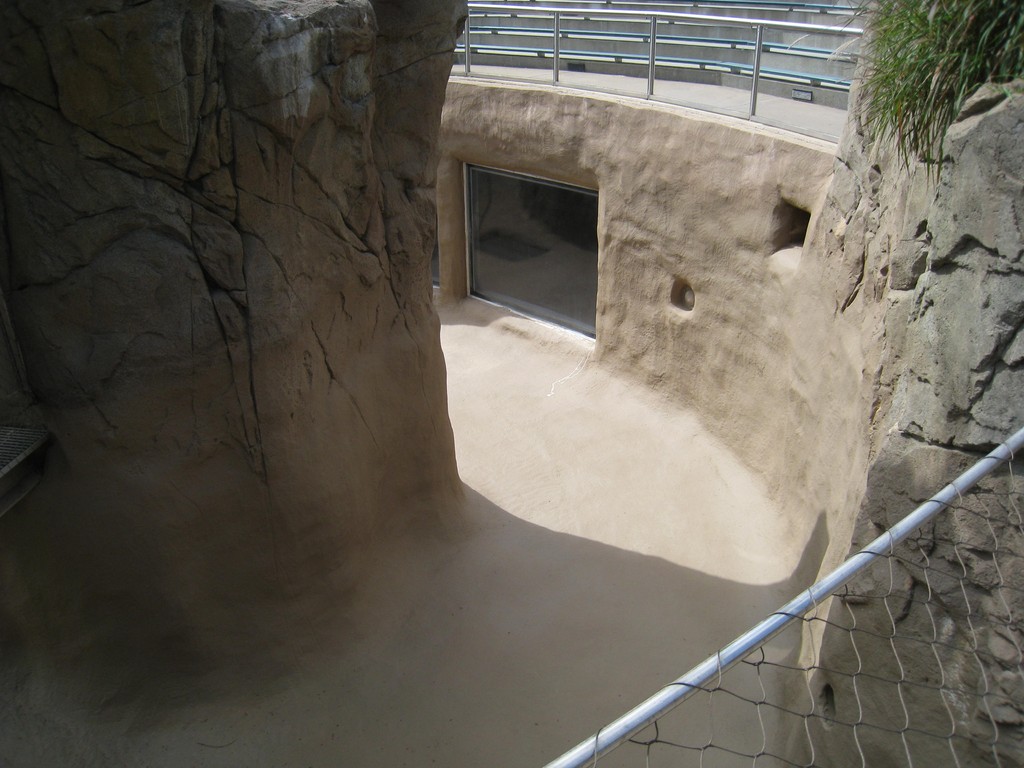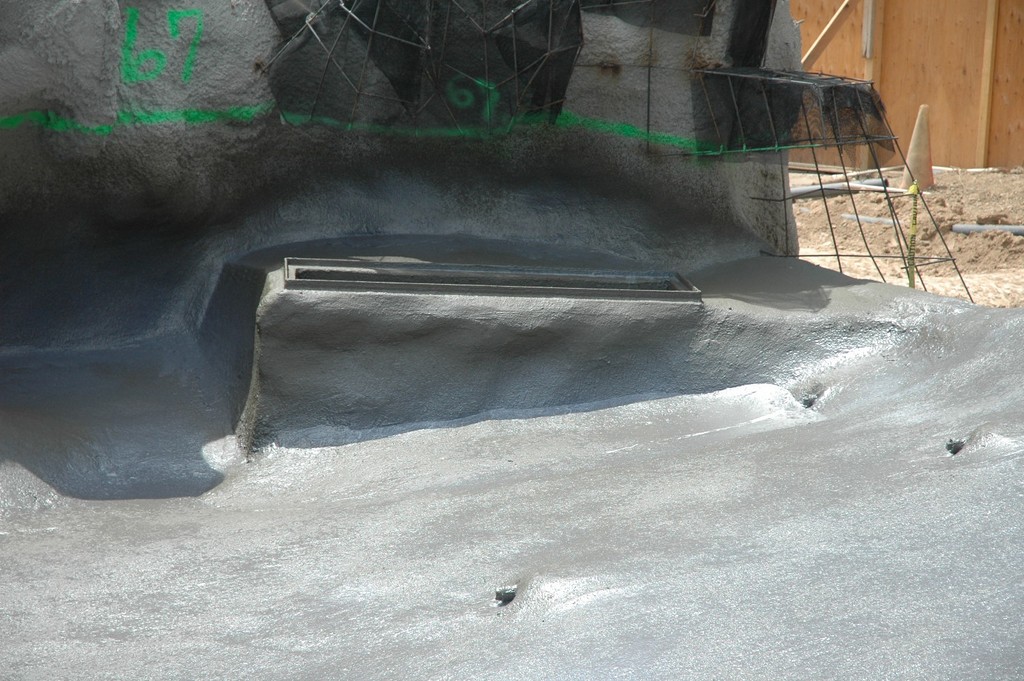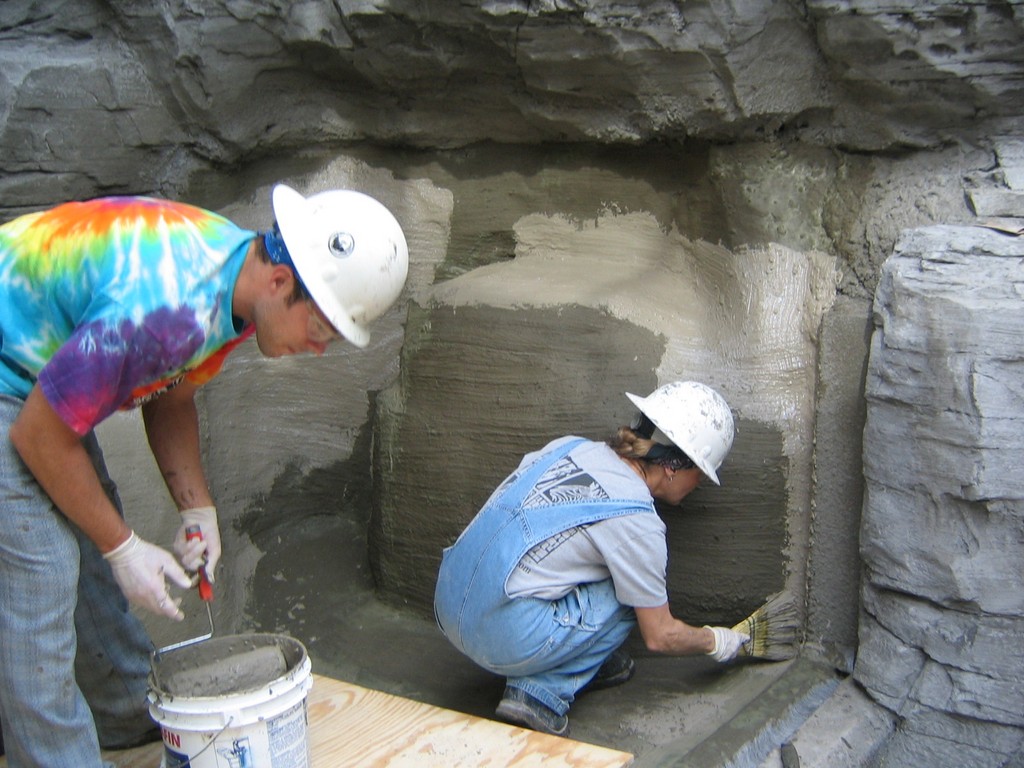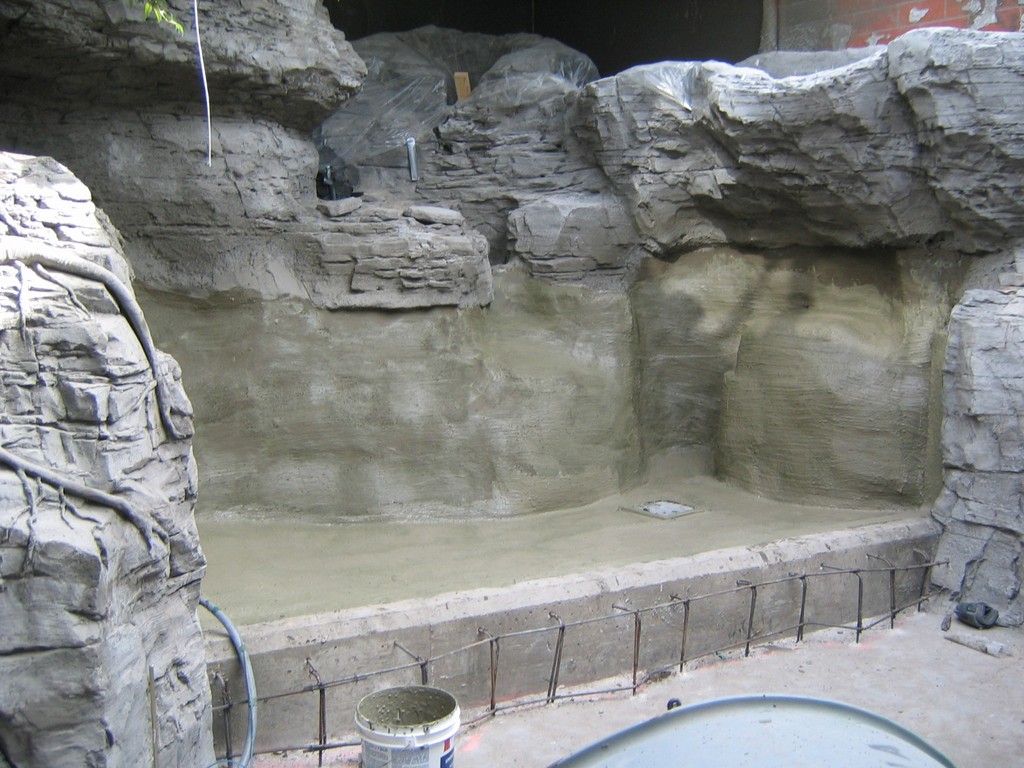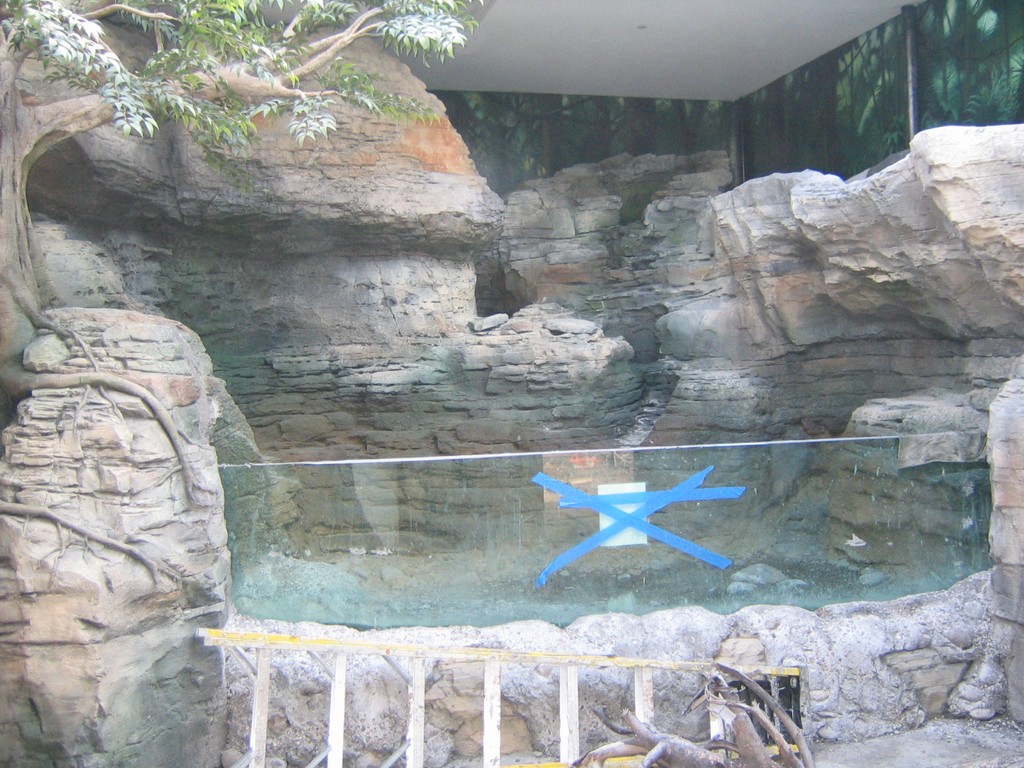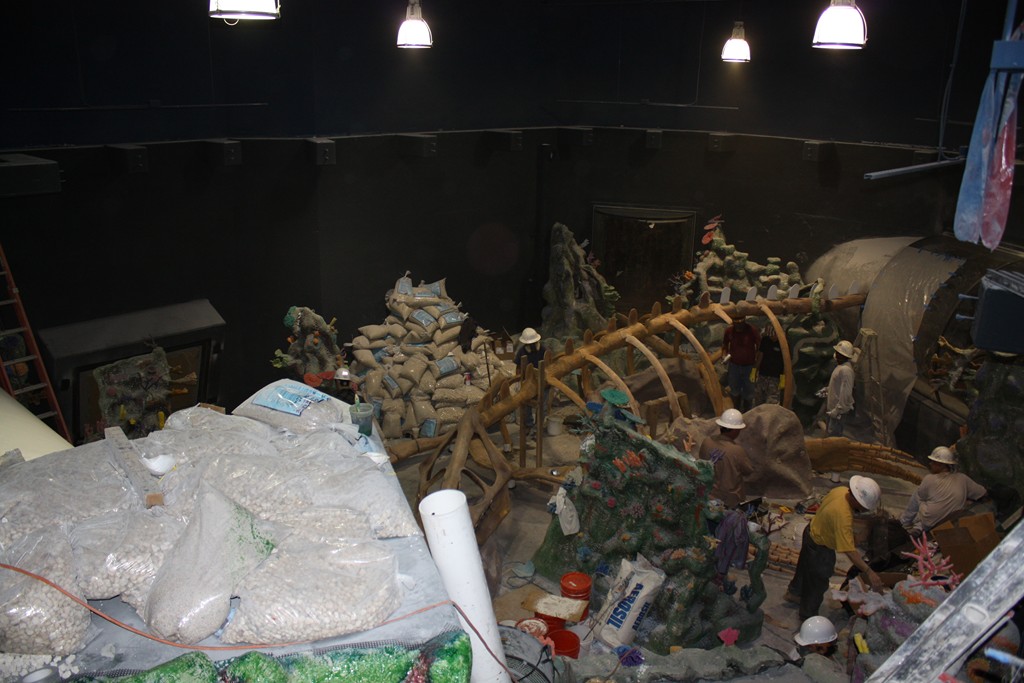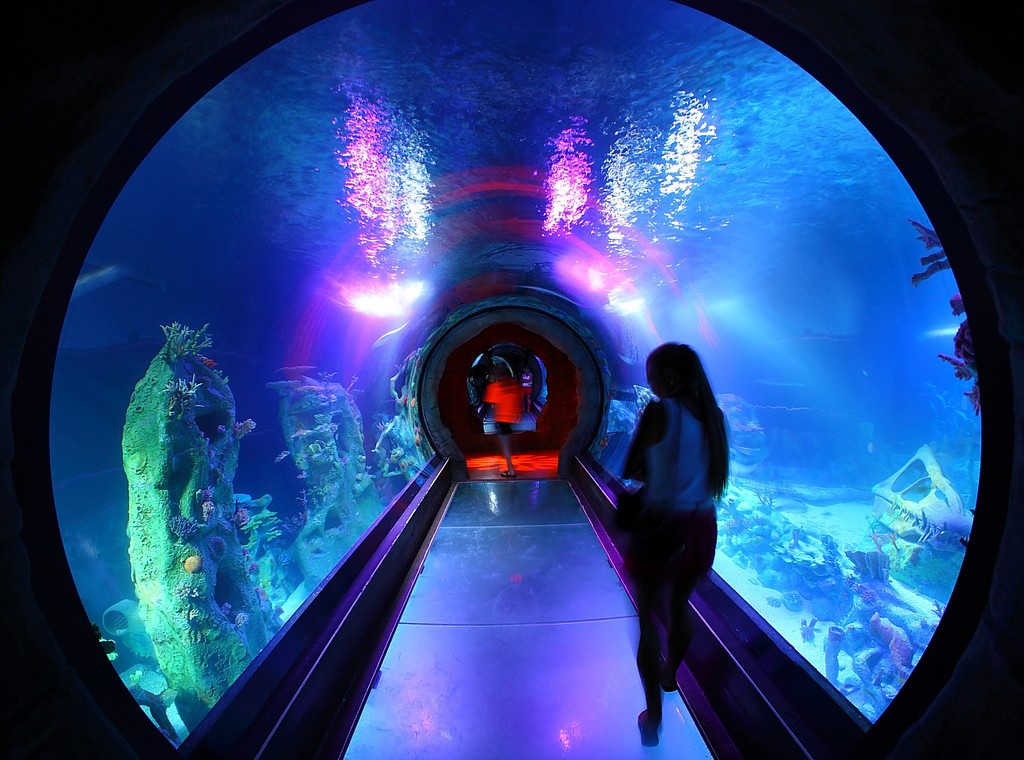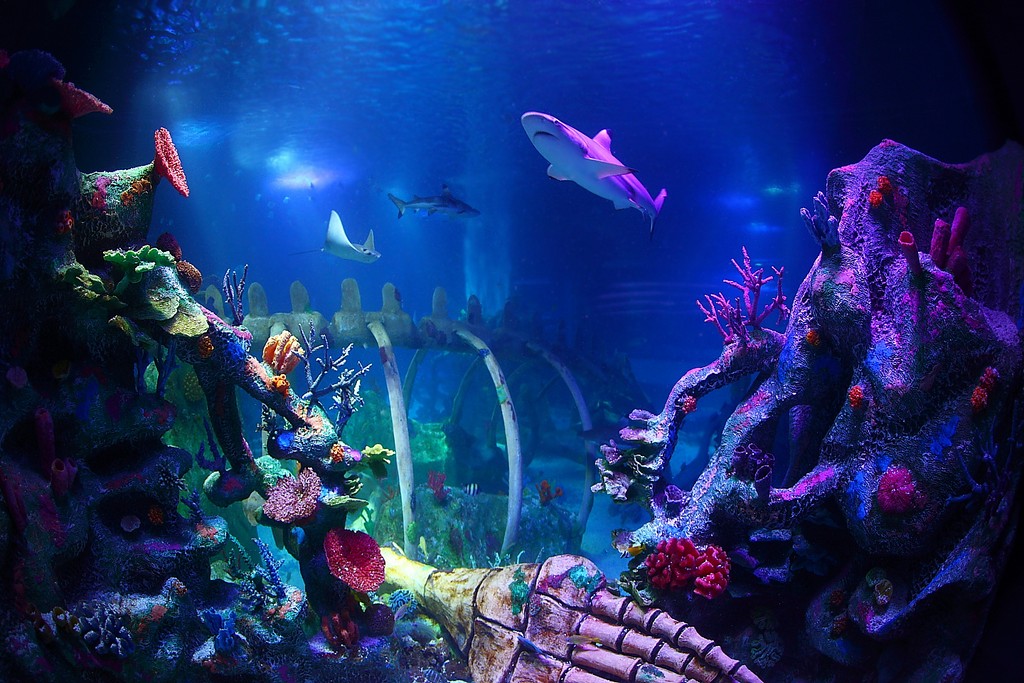Animal Applications
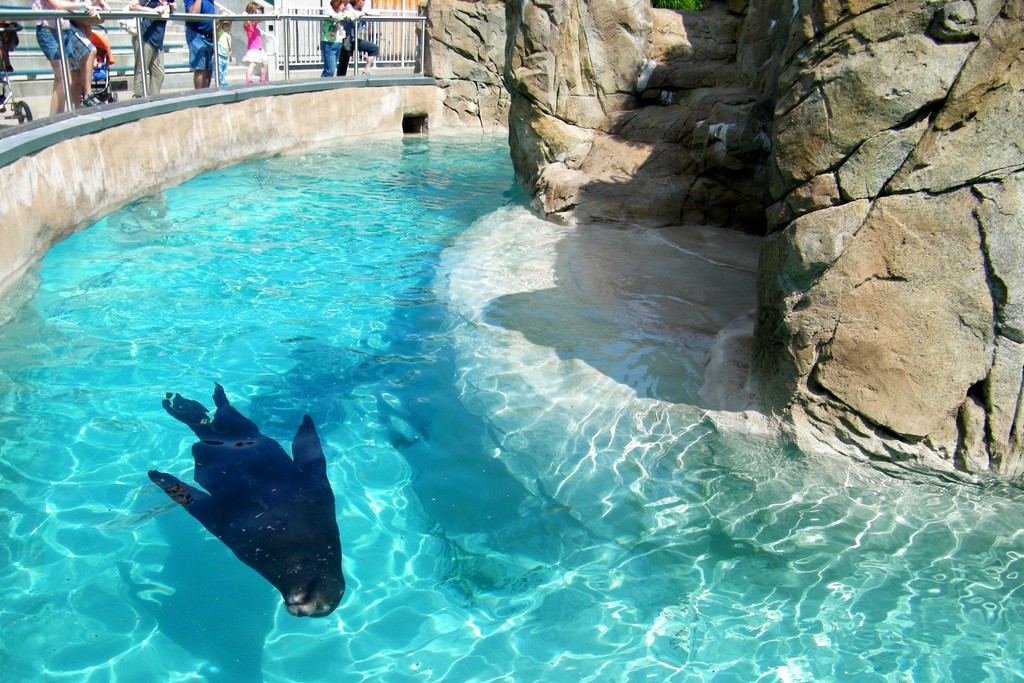
 By Michael Mudrick & Elena Danke
By Michael Mudrick & Elena Danke
Marine and zoological exhibits have always presented watershapers with a variety of specific technical challenges, not the least of which is devising a waterproofing system that will keep these vessels watertight, the viewing areas dry and the animal life safe. Here, Michael Mudrick and Elena Danke of Aquafin discuss a variety of lessons to be learned in pursuing these projects – and how they apply to other watershapes as well.
Designing, engineering and installing watershapes for zoological and aquarium applications is never a casual exercise, especially when it comes to waterproofing.
Not only do you have to find a product or combination of products that can accommodate various structural penetrations, adhere to all of the materials being used and, quite often, conform to irregularly shaped surfaces: Whatever material or system you select must also accommodate the needs of the creatures that will eventually dwell in these spaces.
As waterproofing specialists and engineers, we’ve dealt with these projects at Aquafin (Elkton, Md.) for more than 20 years. Among the principal lessons we’ve learned is that each installation is unique – but that there’s much to be taken away from each experience that can be applied elsewhere. We’ve also learned that it’s best when this experience is shared openly so that all watershapers can reap the benefits.
Along the way, we’ve observed that product selection is more complex than many watershapers recognize and that, as important, proper application is crucial to product performance and longevity. In addition and finally, we’re writing this because we see that the waterproofing techniques we’ve developed through these immense (and immensely complicated) zoological and marine installations have direct implications for other forms of watershaping.
Through our experience, in other words, we’ve come to see our role as not just that of a material supplier, but also as a consulting member of a larger team with an active role in a project’s success. As is so often true, it helps in these situations if we get involved right from the start – reviewing and providing drawings, offering installation training and support and generally working with the architects, contractors, applicators, related suppliers and property owners to ensure that all of the right products are selected and properly installed.
ZERO TOLERANCE
With large-scale zoological and marine exhibits, for starters, we know that the majority of leaks and waterproofing failures take place in the areas around viewing panels and windows and at other points where the shell has been penetrated.
Where even a newcomer would recognize that sealing the areas around viewing panels and windows would be an issue, we’re invariably amazed by the great number of penetrations incorporated into the design of these vessels. It begins, of course, with all of the intakes and outlets for the circulation and filtration systems, but then there are the points where decorative components of the exhibit must be anchored, where viewing panels are installed, where lighting fixtures are placed and more.
These are all penetrations of different sizes and orientations and materials, and waterproofing them successfully can require use of a number of different materials and techniques. As a result, versatility is very much the watchword as planning proceeds.
| The variety of shell penetrations in marine and zoological exhibits is quite broad – not just for numerous lights and circulation inlets and outlets, but also quite commonly for viewing windows of various shapes and sizes. As a result, a number of different waterproofing techniques, materials and approaches must be applied, all with great and specific care. |
To create zero-tolerance, absolutely watertight penetrations, we generally recommend use of a combination of fluid-applied cementitious products along with gaskets and sealing tapes. The gasket fits tightly around the penetrations and is then embedded in two coats of the waterproofing material to ensure a completely watertight seal.
Next, joint-sealing tapes are placed atop the fluid-applied waterproofing material while it is still wet in all wall/floor or wall/wall corners – an addition that enables us to provide a seal that will be leak-proof even if movement causes the fluid-applied material to crack in the joint. This works because the tapes themselves are specially designed to be both waterproof and highly flexible, with up to 600 percent elongation.
(This contrasts with mechanical fastening or anchoring, where if the waterproofing membrane is compromised, leaks will potentially develop. The advantage of a fluid-applied material is that the fastening system is effectively and directly embedded in the wet material and will form a waterproof seal when it cures.)
All of that work with pipes and anchor bolts seems pretty pedestrian, however, when compared with the challenge of working with big viewing panels – typically a crucial inclusion because enabling visitors to experience these exhibits and their inhabitants at close range provides revenues that help to keep these facilities going and thriving. They may offer splendid views of very special worlds, but they also offer opportunities for leakage and even a potential for disaster.
These viewing panels are typically made of acrylic, which isn’t necessarily the most compatible of all materials with these exhibits’ concrete shells. This raises the bar when it comes to effective waterproofing and makes it an area where we frequently practice what we preach by calling in the experts.
SEE AND BE SEEN
One project in particular where we needed help was at Sea Life Arizona. Located in land-locked Tempe, it opened in May 2010 with the ambition to provide kids with a fun, interactive and educational experience of marine life with an aquarium large enough to house more than 5,000 creatures. The tour opens with a visit to an Arizona park lake, then takes visitors to the shore of the Pacific and on out to the ocean depths.
The main tank holds more than 160,000 gallons of water and includes not only traditional underwater viewing windows, but also features a 360-degree underwater viewing tunnel that allows visitors sublime access to an underwater world.
Generally, the window rebates (that is, the frameworks) for these applications are cast into the concrete shell, but in this particular instance, the plans called for use of stainless steel retaining structures for all of the windows as well as the acrylic tunnel. So rather than the usual challenge of bringing concrete and acrylic together, we had to add stainless steel into our considerations – a novelty that led to our collaboration with an expert.
| It’s fairly common in aquatic zoological exhibits for there to be bulkhead-style viewing windows of a sort familiar to any watershaper who has used a big acrylic panel in a swimming pool project. Extensive waterproofing is required to make certain water doesn’t somehow migrate around the panel to mar the aesthetics of the viewing area, but the construction detail itself is fairly straightforward if due care is taken in forming the openings. |
Bob Gurth, owner of Aquatic Exhibit Group (Wheat Ridge, Colo.), is an Aquafin-certified applicator who, for more than two decades, has designed and built complex aquatic environments. Among his many projects, he has dealt with a number that presented interesting challenges for waterproofing around the viewing panels – and this was another project that proved to be right up his alley.
What he recommended was a schedule in which the concrete tank’s walls were waterproofed with Aquafin 2K/M, a cementitious, fluid-applied crack-isolation membrane. This was brought all the way to the edge of the steel in the window rebates. At that point of contact, an epoxy product was used to prime the steel window frames so that the fluid-applied material would adhere properly.
The windows were lifted and set into position, then a special silicone sealant was used to create the final seal between the epoxy and the acrylic. This was an unusual finishing schedule – one we would not have pursued without Gurth’s expert guidance.
The general lesson here: Just about anything you need done when it comes to waterproofing a pool or spa or fountain can be done, and it’s more than helpful in doing so to be able to call on professionals with the expertise required to get the job done right the first time through.
CLIMATE COUNTS
The challenges that flow from unusual intersections of materials are one thing; the problems presented by climate and temperature changes are quite another – often dramatically so. Indeed, as every watershaper who works in concrete in any locality where seasons are a factor knows that temperature fluctuations can create substantial amounts of movement in concrete structures.
Take the case of the Denver Zoo and its new Asian Tropics exhibit as an example: When planning this 16-acre complex, the project team ran up against a variety of interesting waterproofing challenges with its large outdoor watershapes.
|
Completely Harmless Unlike most decorative watershapes, large aquariums and zoo exhibits are designed to meet the specific needs of their occupants – creatures that come with specific sets of needs that must be met if they are to survive in captivity. As a rule, fish and sea life spend all of their time submerged and have little if any direct contact with the coatings applied to keep their environments waterproof, but penguins and elephants and other animals that move from the water to dry land can spend a lot of time in contact with their surroundings. As a result – and in addition to being resistant to saltwater and/or the chemicals used to balance water chemistry – the coatings and products used in these settings absolutely cannot release any harmful substances back into the water. This means they must be solvent-free, completely non-toxic and certified for safe contact with drinking water. — M.M. & E.D. |
In August, the average temperature in Denver ranges from daytime highs in the 90s to nighttime lows in the 60s – a healthy but bearable swing. In the winter months, however, the highs might creep into the 40s with lows dropping well below freezing and even down into the teens. It’s obvious that these seasonal temperature changes will cause major thermal expansion and shrinkage in the concrete.
And as the concrete shell of the watershape moves, the waterproof coating must accommodate this movement; otherwise, cracks will form and leaks are inevitable. For all their versatility, epoxy-based products are generally not up to that sort of challenge. Instead, we’ve found through experience that cement-based products – when modified using polymer additives – can achieve the significant sorts of elongation capabilities that are required in these situations.
Again, it helps if we’re involved early on, because we know that curing of the concrete shell is another critical factor in material selection. Epoxies and urethanes, for example, require average curing times for the concrete substrate of 28 days – and a completely dry surface is required. By contrast, breathable cementitious coatings can be installed as few as three days after concrete placement.
(These product distinctions are larger issues in repair and rehabilitation work: We’re generally called in to fix problems in wet or damp areas where getting things dry generally happens only after the repair products have been installed.)
Taking all of this into consideration, the project team for the Asian Tropics exhibit chose to go with a combination of cementitious products for waterproofing the outdoor watershapes.
We started by adding a liquid crystalline waterproofing admixture to the shotcrete batches when they arrived at the site. By introducing the waterproofing agent directly into the shotcrete mix, we ensured that the entire structure would effectively be waterproof on both the positive and negative sides, thereby protecting the reinforcing steel from corrosion and damage by not only keeping the exhibit’s water in the tank, but also by keeping the groundwater from penetrating the outside of the shell.
As an additional layer of protection, we waterproofed the entire inside surface of the shell on the positive side with our highly flexible cementitious fluid-applied membrane. Offering greater than 70 percent elongation, this coating will allow the concrete to “move” in response to thermal shifts both high and low. We also used this product along with joint-sealing tapes and gaskets to secure all penetrations and drains.
MATERIAL DIFFERENCES
In constructing watershapes in these unusual environments, we typically encounter wide varieties of building materials, from concrete and steel to fiberglass, densglass gold and other materials.
All of them need to be waterproofed or treated in some manner, and we always explain to product teams and contractors that it is advantageous to reduce the number of different materials they use because it will significantly simplify the waterproofing tasks we need to perform. Of course, they don’t universally cooperate with that recommendation, which is why we’ve developed versatile, efficient waterproofing agents that will adhere to a range of different materials and surfaces.
This is an important point, because not all materials available in the marketplace have that degree of versatility. So when we get involved, we want to know up front which materials need to be sealed so we can make recommendations about products to be used with confidence that they will work. Sometimes things aren’t that simple, of course, but in some cases one product will do – which property owners like because it saves money.
| In more elaborate projects, all sorts of complex, additional shell penetrations can become factors in the waterproofing program. In the case of Sea Life Arizona, for example, the decorative elements within the 160,000-gallon main tank all had to be anchored into the shell, and the installation of the acrylic viewing tunnel was so complex that even we brought in a waterproofing consultant to make certain everything would perform as expected. |
When Chatanooga’s Tennessee Zoo added its new penguin facility, for example, cost was definitely a factor, and the designers were trying to cut costs by reducing the volume of concrete to be used in the construction. To make this happen, they decided that only the water-holding portion of the exhibit was to be concrete, while the surrounding walls were to be built with DensGlass Gold gypsum sheathing from Georgia Pacific (Atlanta).
It seemed a reasonable solution, but it set aside the fact that penguins can make a mess and that cleaning up after them is definitely an issue.
The upshot was that the entire exhibit had to be able to withstand high-pressure water-jet cleaning as well as mechanical brushing. Basically, the management decided that what they wanted was a facility that could be cleaned from top to bottom without having to worry about exposing the walls to water – easy to achieve with concrete, not so easy with gypsum sheathing.
This sent the designers on a quest for a material that could run up beyond the shell and onto the walls and adhere effectively to both materials as a monolithic finish that would withstand the water jets and the brushes as well as the high pH levels caused by penguin waste. This led them to us and our coating system, which has the ability to adhere to a variety of substrates while providing a pH-resistant, non-toxic finish – all within budget.
REACHING OUT
Clearly, these sorts of zoological and marine environments pose unusual challenges to any company that gets involved in such projects. But the lessons about waterproofing to be learned in these critical applications definitely carry over to other projects where adequate waterproofing is an issue.
The keys include good planning coupled with careful installation. More than once, we’ve been called in after a system has failed, and invariably it has to do with the fact that the wrong product was selected – or the right product was used improperly. It’s not that they didn’t specifically call us, because there are other suppliers out there who do a good job with waterproofing Instead, the project team hadn’t seen a need to get expert help early in the design process and ended up needing to foot the bill for what proved to be a tremendously expensive repair job.
If you take only one message from this article, it should be this: If a project calls for it, there are no shortcuts when it comes to waterproofing. This is why we always stress the importance of working with experts who understand product selection and application and know the sorts of risks that come with compromise.
You don’t need to work on a penguin exhibit or a shark tank to appreciate the value of getting things right the first time through. The lessons to be learned in those critical and even life-or-death applications easily transfer to any context where care is required and you don’t want to leave the success of a project to chance.
If you do get the opportunity to pursue this sort of work, keep your mind open and recognize the fact that there lots of professionals out there who are ready to help – including some, like us, who specialize in keeping water where it belongs!
Mike Mudrick is product manager at Aquafin, a manufacturer of waterproofing products based in Elkton, Md. A graduate of Temple University with a degree in chemistry, he has been involved in the construction and waterproofing industries for more than 20 years and joined Aquafin in 2000. Elena Danke is Aquafin’s director of marketing. A graduate of the University of Maryland (College Park) with a degree in marketing, she started at Aquafin in 2005 in outside sales, then spent three years abroad working for the partner company – Aquafin International – doing international marketing and sales support before returning to Maryland in 2009 to assume her current role.










